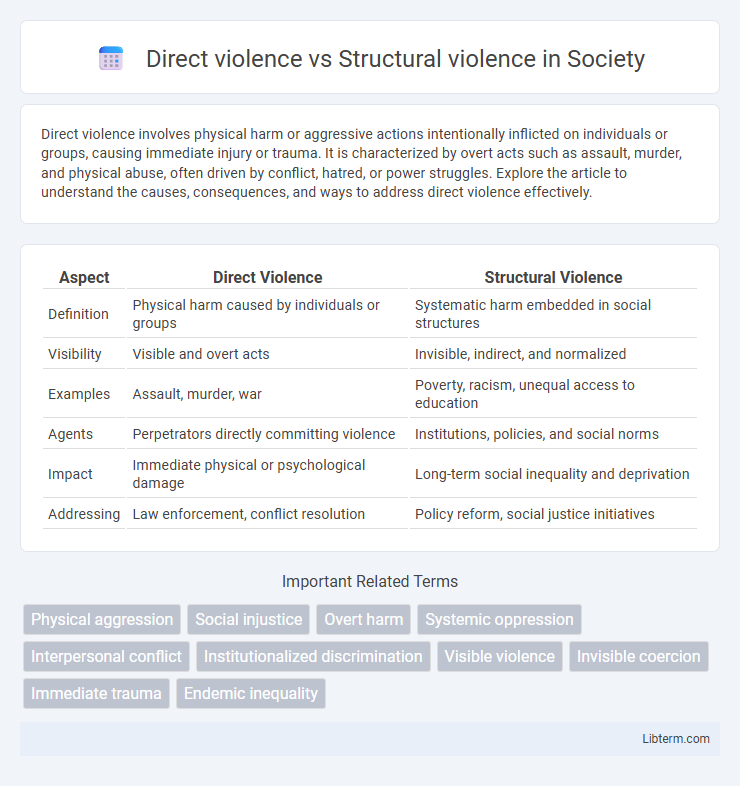Direct violence involves physical harm or aggressive actions intentionally inflicted on individuals or groups, causing immediate injury or trauma. It is characterized by overt acts such as assault, murder, and physical abuse, often driven by conflict, hatred, or power struggles. Explore the article to understand the causes, consequences, and ways to address direct violence effectively.
Table of Comparison
| Aspect | Direct Violence | Structural Violence |
|---|---|---|
| Definition | Physical harm caused by individuals or groups | Systematic harm embedded in social structures |
| Visibility | Visible and overt acts | Invisible, indirect, and normalized |
| Examples | Assault, murder, war | Poverty, racism, unequal access to education |
| Agents | Perpetrators directly committing violence | Institutions, policies, and social norms |
| Impact | Immediate physical or psychological damage | Long-term social inequality and deprivation |
| Addressing | Law enforcement, conflict resolution | Policy reform, social justice initiatives |
Understanding Direct Violence: Definition and Examples
Direct violence refers to physical acts of aggression or harm inflicted by an individual or group, such as assault, murder, or abuse. It is characterized by immediate, visible actions that cause bodily injury or death. Examples include armed conflict, domestic violence, and police brutality.
What Is Structural Violence? Key Characteristics
Structural violence refers to systematic ways in which social structures harm or disadvantage individuals by preventing them from meeting basic needs, often embedded in institutions like laws, economic systems, and social hierarchies. Key characteristics include invisibility, as it operates subtly without direct perpetrators; systematic inequality, where marginalized groups suffer from unequal access to resources, education, and healthcare; and normalization, making it difficult to challenge because it is often accepted as the societal status quo. Unlike direct violence, which is physical and visible, structural violence perpetuates long-term harm through deeply ingrained social and institutional practices.
Historical Context of Direct and Structural Violence
Direct violence, characterized by physical harm or overt acts of aggression, has been evident throughout history in wars, genocides, and colonial conquests. Structural violence, embedded in societal systems and institutions, manifests as systemic inequality and social injustice, often persisting invisibly over centuries, such as in apartheid in South Africa or caste discrimination in India. Historical context reveals that while direct violence is episodic and visible, structural violence is chronic and insidious, shaping the lived experiences of marginalized populations over time.
Comparing Manifestations: Direct vs Structural Violence
Direct violence involves visible, physical acts such as assault, murder, or war, where harm is immediately identifiable. Structural violence, in contrast, is embedded in social, economic, and political systems, manifesting as inequality, poverty, and discrimination that indirectly cause suffering. While direct violence produces acute injuries, structural violence generates chronic harm by restricting access to essential resources and opportunities.
Root Causes Behind Different Types of Violence
Direct violence involves observable physical acts causing immediate harm, often rooted in specific conflicts or social tensions. Structural violence stems from systemic inequalities embedded in social, economic, and political institutions that marginalize groups and limit access to resources or rights. Both forms of violence share root causes such as poverty, discrimination, and power imbalances that create environments where direct violence is more likely to occur.
The Role of Power Dynamics in Perpetuating Violence
Power dynamics fundamentally shape both direct and structural violence by determining who holds control over resources, decisions, and social norms. In direct violence, power manifests through physical force or overt aggression to impose dominance, while structural violence operates more insidiously via institutionalized inequalities and systematic deprivation embedded within societal structures. These asymmetrical power relations legitimize and perpetuate harm by obscuring the root causes of violence, maintaining social hierarchies, and limiting access to justice and equality.
Societal Impacts: Immediate and Long-term Effects
Direct violence causes immediate physical harm and trauma, leading to acute societal disruptions such as fear, instability, and loss of life. Structural violence, embedded in social systems and institutions, generates long-term inequality, poverty, and limited access to resources, perpetuating cycles of marginalization and social injustice. Both forms undermine social cohesion and economic development, with direct violence disrupting daily life and structural violence eroding foundational equity over generations.
Addressing Direct Violence: Policies and Interventions
Addressing direct violence involves implementing targeted policies such as stricter law enforcement, community policing, and victim support services to reduce immediate physical harm. Interventions include crisis response teams, conflict resolution programs, and educational campaigns aimed at promoting nonviolent behaviors. Data-driven approaches help allocate resources effectively and evaluate the impact of direct violence reduction strategies.
Tackling Structural Violence: Reform and Advocacy
Tackling structural violence requires comprehensive reforms in social, economic, and political systems that perpetuate inequality and injustice. Advocacy efforts focus on changing policies related to education, healthcare, housing, and labor rights to address systemic barriers faced by marginalized communities. Effective reform involves collaboration between governments, NGOs, and grassroots organizations to create equitable access and dismantle institutional discrimination.
Towards Peace: Integrating Solutions for Both Types
Addressing peace requires integrating solutions that tackle both direct violence, characterized by physical harm and overt conflict, and structural violence, which stems from systemic inequalities embedded in social, economic, and political institutions. Effective strategies combine immediate interventions, such as conflict resolution and protection measures, with long-term structural reforms aimed at dismantling discrimination, poverty, and institutionalized injustice. Holistic peacebuilding efforts prioritize collaboration between governments, civil society, and international organizations to ensure sustainable peace by mitigating direct aggression and addressing underlying structural causes simultaneously.
Direct violence Infographic

 libterm.com
libterm.com